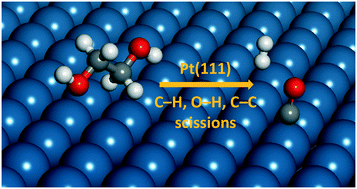Ethylene glycol reforming on Pt(111): first-principles microkinetic modeling in vapor and aqueous phases†
Abstract
First-principles, periodic density functional theory (DFT) calculations and mean-field microkinetic modeling have been used to investigate the decomposition of ethylene glycol for hydrogen production on Pt(111) in vapor and aqueous phases. All dehydrogenated species derived from ethylene glycol (C2HxO2, x = 0–6) and methanol (CHyO, y = 0–4), and all elementary C–C, C–H, and O–H bond breaking steps are included in the microkinetic model. Reaction path analysis in vapor phase indicates that both initial C–H and O–H dehydrogenation steps are kinetically relevant at all temperatures (470–530 K). Initial O–H bond cleavage is reversible at low temperatures but accounts for an increasingly dominant fraction of the total reaction flux at higher temperatures. C–C bond scission is observed only after significant dehydrogenation (x ≤ 3) and is more likely to happen in surface intermediates where one of the cleavage products is CO. The process is highly selective to the production of H2 compared to methanol. For aqueous-phase model development, free energies of solvation were computed for all surface intermediates and transition states using a continuum solvation approach. Our aqueous-phase microkinetic model predicts a 0.4 eV lower apparent activation energy and an order of magnitude larger turnover frequencies. Initial C–H bond cleavage becomes more important but the general trends are similar to the vapor phase, suggesting that the reaction chemistry is similar in both vapor and aqueous phases.


 Please wait while we load your content...
Please wait while we load your content...